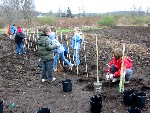News & Events
Only in April
Posted on Monday, April 30, 2007
Written by Clarence Harms, Director of the Field Station
March had almost yielded to April when, on a delightful clear day, children from Westminster's preschool came out to explore composting. They did not flinch. They brought with them what they thought might make good plant food. We mixed "their things" and "my things" together in a bin for them to take back to the classroom for regular stirring. The highlight of that mixing operation was the addition of earthworms to the bin. Both children and worms appeared to be happy!
Then April came on us "like a Lion" (isn't that supposed to happen in March?). April 2007 was a one-of-a-kind month at the Field Station. The weather was strange when, weather-wise, an "Easter" turned into a "Christmas." But the calendar here, regardless of the late snow, freezing temperatures or heavy rain, was filled with many very special events.
Art students of Peggy Cox came out twice to sketch and draw microscopic details of ordinary plant materials. Cells stained red or green and viewed under the microscope are certainly worthy of interpretation by artists. One student remarked, "Wow!" when seeing a stained cross section of an ordinary tree stem with its annual growth rings.
The first week of April also brought Dan Kuzma of Youngstown State University to the Field Station for the first time. Dan is in charge of the recycling program at YSU and they have just begun a composting operation with campus food waste. We compared notes, successes and frustrations in the handling of campus compostables. We agreed that colleges and universities must teach sustainability as a way of life for the future.
The week leading to Earth Day, commemorated this year on April 22, is always extraordinary. A highlight of that week was a field day for 40 first graders from Mohawk Elementary School arranged by a Westminster student, Danielle Hogue. Standing near the three flags at the gate of the Field Station I quizzed the students. "Top flag, the Stars and Stripes?" Obvious. "What about the blue flag with the big white "W"?" One timid girl knew it was for Westminster. "And the green flag? What's so important about green?" To my surprise and joy several students knew about Earth Day and even the significance of the color green. Good teachers, good students! With some basic instruction and the color-coding of stakes and trees, the children planted 80 seedlings of nine species in our Nursery at the Field Station. We drew lessons from babies staying comfortably in a hospital nursery until they are ready to go home. That's what will happen to these seedlings. We talked about trees needing nourishment. This comes through the roots and uses the tiniest of chemicals (I made no mention of nitrate or phosphate ions) from the compost that we provide the seedlings. A tradition here at the Field Station when planting trees is the "Tree Dance" while chanting, "I love you tree . . . I love you tree." Small feet press the fresh soil around the roots and, we hope, bond the child with the tree . . . and the earth. Then a bit of water, also a nourishment, and the tree is planted, ready to get its start for a later transplant to a permanent home.
Composting continued unabated in April. The warmer temperatures (finally) helped speed the process of turning "unmentionables" into a good, clean soil conditioner. Two days after Earth Day a truckload of compost was donated to Shenango On The Green for spring landscaping. Cy King, a resident involved with the project, called it black gold . . . and it is! Smaller quantities were given away to local residents who brought a trash can-size container to the Field Station. Most of the compost generated between November and April will be used for planting new trees and nurturing older ones at the Field Station.
On the last Thursday of April, Mohawk students from other classes were bused to the Fayette-New Wilmington Road for adventures in horsemanship at the Little Neshannock Stables and more tree planting. Westminster students, Jennifer Ramsey and Kendal Kennedy, arranged for this field trip. They had just concluded a unit on weather. They had learned about rain gauges and thermometers. I asked them, "What makes weather?". They knew. I showed them more instruments, like the anemometer and barometer, in the Travis Weather Station. Then the children made it rain into the rain gauge with sprinkler bottles to see how much shaking it takes to make one inch of precipitation.
Arbor Day, the last Friday of April, is that national, historic day attributed to J. Sterling Morton who started the tradition of tree planting in Nebraska in the 1800s. We always plant trees at the Field Station during Arbor "week." Last year, as a living tribute to Sandy Edmiston, we planted 300 tree seedlings, mostly white oaks in our Microforest. This year our attention to trees added more than 300 to the Nursery plantings begun by small children. Appropriate but sad is that all spring plantings at the Field Station are living memorials: to the 33 people who died in the tragedy at Virginia Tech on April 16. We remembered the fallen and the wounded. Students in Westminster's Green Party walked out to plant on the actual Arbor Day. The following day some employees of Wal-Mart in Union Township, Westminster alumni and friends from various places were here to breathe fresh air and plant trees.
If April came in like a lion, it left with this LINE: "Make the world a better place, plant a tree so you can breathe the fresh air." Only in April could all of this happen!

More Stories



